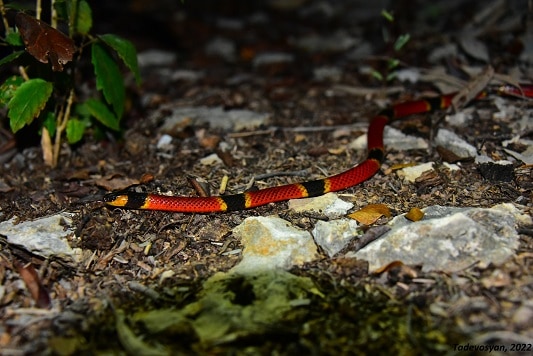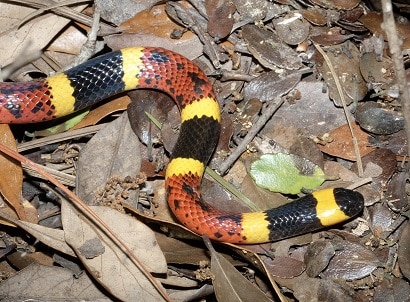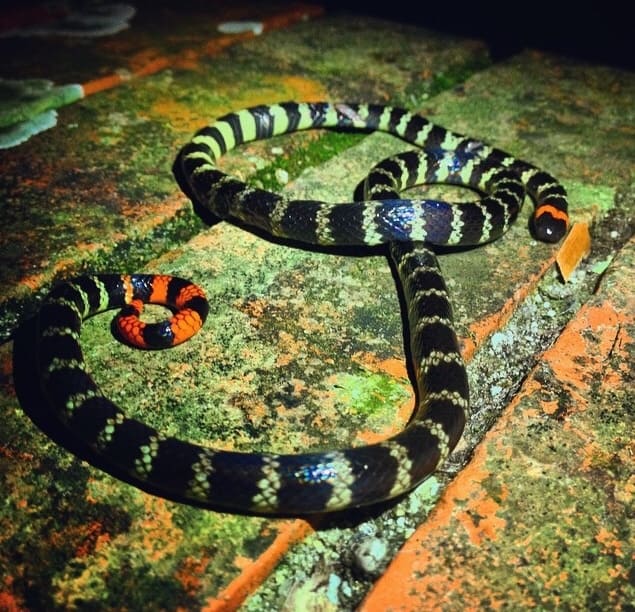| 1 | Ribbon coral snake |

Probably the most abundant coral snake in South America. While no coral snake inhabits all of Brazil, Micrurus lemniscatus comes the closest, only skipping Rio Grande Do Sul in the extreme south adjacent to Uruguay. Their habitats are flexible, including humid forests, dry forests, savannahs, and deforested areas.
The ribbon coral snake measures 60-90cm, and was named for its especially thin body. Their bite is particularly nasty. An Ecuadorian male victim experienced excruciating pain down his entire arm. The neurotoxic symptoms were slow to arrive, appearing at 14 hours, but when they did, they included severe breathing difficulties, as the man was placed on supplemental oxygen followed by a full mechanical ventilator. He also experienced bacterial pneumonia, bronchial obstruction via mucous plugs, and rhabdomyolysis. There were only mild blood clotting difficulties, so it seems that this venom strongly targets the lungs.
One ingredient is a powerful neurotoxin called lemnitoxin, identified in 2016. This was closely related to a neurotoxin found in the Central American coral snake, called nigrotoxin. Interestingly, it was also related to Australian neurotoxins: notexin in the tiger snake, and textilotoxin in eastern brown snakes.
Ribbon coral snakes have a varied diet, including snakes, eels, fish and amphisbaenas. Ribbon coral snakes bite their prey at mid-body, before releasing and waiting for 30 minutes. Then they return to their weakened prey, and swallow by the head.
| 2 | Variable coral snake |

A species with several morphs, with red and black nearly always present, but yellow sometimes missing or barely visible. In fact, this is probably the most variable coral snake out of all 82. The morph above is fairly typical, but then you have editions like this and this.
Variable coral snakes inhabit southern Mexico, Belize and Guatemala. The longest ever measured 98.2cm, and was found in Mexico’s Yucatán peninsula. This is a neurotoxic species containing alpha-neurotoxins and three finger toxins. Micrurus diastema has the typical snake diet, mostly eating fellow serpents. At least 5 species are confirmed, including blotched hooknose snakes (Ficimia publia) and red coffee snakes (Ninia sebae). This is the most abundant coral snake in Mexico’s Yucatán peninsula, where it lives alongside such venomous snakes as the Yucatan cantil and Tzabcan rattlesnake.
The Micrurus coral snake family contains 82 members, but according to a 2016 evolutionary tree, variable coral snakes are part of a 4 member subgroup within this, which are genetically close. The other members are the eastern coral snake, Texas coral snake, and Costa Rican coral snake (Micrurus mosquitensis).
| 3 | Texas coral snake |

A coral snake of the deep south, which reaches a maximum of 118.1cm. This was originally a subspecies of the eastern coral snake found in Florida, but is now independent. Back in the glory days, eastern coral snakes had 5 subspecies, but after the great separation, 4 of these were switched to the Texas coral snake. Micrurus tener is easily the more common of the two species. They inhabit most of Texas and western Louisiana, but also a vast chunk of Mexico, including the outskirts of Mexico city down south. Texas coral snakes have relatively flexible habitats for their family, and inhabit arid areas, woodlands and moist forests alike. They can reach 2155 metres above sea level in Guanajuato, Mexico.
At first glance, the eastern and Texas coral snakes are impossible to distinguish. The colours and ordering of the colours is identical, but there’s one subtle difference. Both species have a fully black face, a yellow lower head (starting behind the eyes), and a pitch black neck collar. In the Texas coral snake, the black neck band is larger, extending up the head, reaching the tips of the parietal scales (two large scales on the top of the head). In the eastern coral snake, the black doesn’t touch the parietal scales – essentially, the yellow band on their head is larger.
Texas coral snakes have a relatively mild venom. According to a study on 82 bite victims, systemic symptoms were rare, while swelling, pain and tingling affected nearly 90% of patients. One weird skill is producing a popping sound when threatened, which is startling to people who have never heard it before. Texas coral snakes also hold the record of most northerly coral snake in the world, in south central Arkansas on the northeast limit of their range.
| 4 | Argentinian coral snake |

This species holds the opposite record: the world’s most southerly coral snake. Argentinian coral snakes (Micrurus pyrrhocryptus) inhabit roughly the upper two thirds of the country, reaching as far south as Niequen, 39° S in latitude. They also cross the northern border into Paraguay, Bolivia, and southern Brazil. Rather than humid forests, their main habitat is dry chacho, a large swathe of savannah-like grassland and dry woodlands.
Micrurus pyrrhocryptus is most commonly sighted during the wet season, when males embark on their annual quest for females. Their diet consists of snakes, and two confirmed prey are La Villa’s slug-eating snake and Brongersma’s worm snake. The latter is also a prey of the painted coral snake (Micrurus corallinus).
A 2011 study analysed Argentinian coral snake venom, and found that it was firmly in the neurotoxic category. It had virtually no myotoxic (muscle-assaulting) activity, unlike the Amazon coral snake, as there was no rise in the bloodstream biomarker creatine kinase. As well as biting, Argentinian coral snakes will also flatten their body and raise their tails to distract, but they have to be touched vigorously for this to happen.
| 5 | Central American coral snake |

A widespread species which ranges from extreme southern Mexico, to extreme northwest Colombia. Inbetween, they inhabit all 7 Central American countries, and have a bounty of sightings in Guatemala and Costa Rica. Micrurus nigrocinctus reaches a maximum of 115cm, and is a career snake eater with many confirmed species to its name…
- Costa Rican worm snake (Amerotyphlops costaricensis).
- Banded cat-eyed snake (Leptodeira rhombifer).
- Whitenose blind snake (Liotyphlops albirostris).
- False coral snake (Erythrolamprus bizona).
While they mainly eat snakes, any elongated animal that resembles a snake will whet their appetite, including worm lizards like Gymmopis multiplicata. Central American coral snakes have relatively flexible habitats, inhabiting thickets, cattle pastures, coffee plantations and urbans gardens, as well as forests. Their venom is highly neurotoxic, causing paralysis, and they’re recognisable by a tail where the red completely disappears, giving way to alternating yellow-black.
Micrurus nigrocinctus faces many predators in the forests of Central America. Nine-banded armadillos will run up to Micrurus nigrocinctus, flip over in mid-air, and bash them repeatedly with their hard shell until dead. Bird predators include the Lesson’s motmot, which was observed smashing this coral snake against the ground for 3 minutes straight, before flying away into the jungle.
| 6 | Balsan coral snake |

The Balsan coral snake (Micrurus laticollaris) lives solely in southern Mexico, where it has a large chunk of land to call home, including the outskirts of Mexico city. They mainly inhabit tropical deciduous forests, particularly along the course of the Balsas river.
This is a powerfully neurotoxic species, containing both post and presynaptic neurotoxins, the latter being significantly harder to treat with antivenom. According to a 2014 study, the venom produced an “irreversible time- and concentration-dependent neuromuscular blockade” in mice. In 2013, scientists identified a new alpha-neurotoxin in Balsan coral snake venom called MlatA1, believed to be one of the most important.
In Mexico, Micrurus laticollaris is known as “Coralillo de Doble Collar”, as there’s two white bands around its head/neck area. Micrurus laticollaris has a purely black face, which obscures its small beady eyes. Then there’s a white lower head, followed by a black neck band. Balsan coral snakes have very little variation in colour and pattern. Compared to a Texas coral snake, the pale bands are clearly white rather than yellow. So far, its diet is completely unresearched.
| 7 | Red-tailed coral snake |

An easily recognisable coral snake, which can be found up to 2410 metres above sea level, and is especially abundant in sugarcane and coffee plantations. Red-tailed coral snakes are common, but found only west of the Andes. This means Colombia, Venezuela, Panama, and the western half of Ecuador. The furthest they reach is eastern Costa Rica.
With a bright red tail and neck, but no red elsewhere on the body, Micrurus mipartitus is one of the easiest coral snakes to recognise. One of their local names is coral rabo de ají, or chilli pepper tail coral snake. Red-tailed coral snakes have a black face, so black that their eyes are barely visible. They’re mainly black and white, in rapidly alternating bands, which number 34-84.
Micrurus mipartitus is one of the longer coral snake species. For years, the maximum length was reported at 122cm, but in August 2015, this record was demolished. A red-tailed coral snake was collected in the municipality of El Agrado, Colombia, on the west bank of the Magdalena river, and measured at 140.6cm. They also tried feeding it a San Antonio anole (Anolis antonii), but this was rejected in disgust. Red-tailed coral snakes mainly feed on elongated prey. This includes caecilians, and fellow snakes such as the Villmaria spindle snake (Atractus manizalesensis) and Werner’s ground snake.
Red-tailed coral snakes possess a severely neurotoxic venom, but rarely bite. It’s estimated that just 0.4% of snake envenomations in Colombia are caused by coral snakes, so for red-tails, the percentage will be even tinier.
| 8 | Brown’s coral snake |

Another of Mexico’s 16 coral snake species. Micrurus browni sticks to southern Mexico, also crossing into Guatemala, and measures 60-80cm. This coral snake is most common in tropical deciduous forests, where they can be spotted by the sides of roads, in a sudden flash of red and yellow as you drive past. Brown’s coral snake can be found from sea level to above 2000 metres on the rolling Mexican plateau, just north of Mexico city.
This species is firmly a snake eater, and southern Mexican neighbours they’re confirmed to prey on include…
- Freminville’s scorpion-eating snake (Stenorrhina freminvillei).
- Middle American burrowing snake (Adelphicos quadrivirgatum).
- Big Bend black-headed snake (Tantilla rubra).
- Bakewell’s blind snake (Epictia bakewelli).
- Sallae’s earth snake (Geophis sallaei).
Kidney damage isn’t a speciality of coral snake bites, but Micrurus browni does wield this deadly skill, according to a 2020 study. The viability of kidney cells was reduced, while the antioxidant glutathione was decreased, and the biomarker of oxidative damage malondialdehyde increased. Balsan coral snake venom acted similarly. Elsewhere, they have the usual diabolical mixture of alpha-neurotoxins and three-finger toxins. One toxin called MitTx causes intense pain all over the body – this is also found in the Costa Rican coral snake (Micrurus mosquitensis).
| 9 | Desert coral snake |

This species lives only in northern Peru and southern Ecuador, in a thin belt west of the towering Andes mountains. This is a small coral snake, with an all time record of 88 centimetres, but an average of only 35cm. Desert coral snakes (Micrurus tschudii) are poorly named, as they’re not found in true deserts. However, they do gravitate towards dry areas, including dry tropical forest, dry deciduous forest, and desert thorn scrub.
Desert coral snakes have a particularly extreme venom, which consists of 95% three finger toxins. Among the most potent was a unique neurotoxin called tschuditoxin-I, which is structurally similar to the MS-1 neurotoxin found in aquatic coral snakes. It was also similar to an alpha-neurotoxin in Central American coral snake (Micrurus nigrocinctus) venom, yet the antivenom of that species was barely affective against the desert coral snake.
All this means that you should watch where you place your feet in southern Ecuador. Desert coral snakes have a typical pattern of red, black, white, black, white, red, then rinse and repeat. However, the red bands are far thinner than species like the decorated coral snake. In some, all the bands are evenly spaced, and there’s morphs where the red bands are the thinnest. Desert coral snakes have a black face, with a red skull cap.
| 10 | West Mexican coral snake |

The resident coral snake of western Mexico, a realm it shares with the Mexican west coast rattlesnake. Micrurus distans averages at 50cm and reaches a maximum of 108cm. It’s predominantly a snake of tropical dry forests, where they love to bury themselves under leaf litter. Unusually for a coral snake, they also climb trees on occasion. They’ve been observed 4.5 meters high in trees, becoming startled when scientists approach and climbing down to the forest floor.
This is apparently a vengeful coral snake. In western Mexico, one coral snake mimic is the milk snake, which is non-venomous, but shares the red, white and black banding in an attempt to stay alive. Angry at this insult, a Micrurus distans was photographed eating a milk snake in March 2008, in a tropical deciduous forest in Mexico’s Jalisco state. Both measured 70cm, and the milk snake fought back, attempting to constrict its predator, but weakened within 10 minutes from the venom.
The coral snake took 20 minutes to fully swallow its prize, by the head, and then vanished into leaf litter. Other prey confirmed in their diet include longnose snakes (Rhinocheilus lecontei), southwest cat-eyed snakes (Leptodeira maculata), and middle American indigo snakes. Its venom contains the usual neurotoxins, with a helping of myotoxins.
